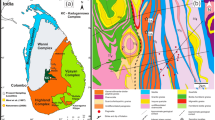Abstract
The mineralogy of a metasomatic sequence formed between ultramafic and quartzofeldspathic protoliths from the Southern Alps of New Zealand consists of a forsterite-antigorite core surrounded concentrically by zones of antigorite-magnesite, magnesite-talc, talc, tremolite, chlorite and muscovite with discontinuous pods of albite associated with the muscovite zone. On the basis of trace element data the original ultramafite-schist contact is positioned between the present tremolite and chlorite zones.
An experimental study of a metasomatic system was undertaken in an attempt to clarify diffusion relationships during the metasomatic event. To simulate the natural event, ultramafic and quartzofeldspathic natural starting materials were tightly packed in a gold tube with a graphite layer between to allow later identification of the original lithological interface. Run conditions were 450° C at 2 kb for 40 days. Phase dissolution and formation were analysed petrographically and component migration was examined with the electron-microprobe. The following hierarchical scheme of component migration, phase dissolution and phase formation is delineated: CO2 migrates from the schist into the ultramafite forming first the antigorite-magnesite zone and then the magnesite-talc zone at higher values of χCO2. These zones are then partially overprinted by the formation of talc due to SiO2 metasomatism. The SiO2 is supplied from the schist by the dissolution of quartz and albite in the region adjacent to the ultramafite. The tremolite zone forms at the expense of the metasomatic talc zone upon the introduction of CaO from the schist into the ultramafite. Concurrent with tremolite formation, MgO migrates from the ultramafite into the schist to form the chlorite metasomatic zone. The growth of the chlorite zone causes dissolution of the pre-metasomatic micas and displaces K2O from the chlorite zone further into the schist. Displaced K2O and Na2O are responsible for the formation of the muscovite zone and the albitite pods.
Similar content being viewed by others
References
Brady JB (1977) Metasomatic zones in metamorphic rocks. Geochim Cosmochim Acta 41:113–127
Chidester AH (1962) Petrology and geochemistry of selected talcbearing ultramafic rocks and adjacent country rocks in North-Central Vermont. US Geol Surv Prof Pap, p 345
Chidester AH (1968) Evolution of the ultramafic complexes of North-Western New England. In: Zen, White, Hadley (eds) Studies of Appalachian geology, Northern and Maritime
Cooper AF (1976) Concentrically zoned ultramafic pods from the Haast Schist Zone, South Island, New Zealand. N Z J Geol Geophys 19:603–623
Curtis CD, Brown PB (1969) The metasomatic development of zoned ultrabasicbodies of Unst, Shetland. Contrib Mineral Petrol 24:275–292
Curtis CD, Brown PB (1971) Trace element behaviour in the zoned metasomatic bodies of Unst, Shetland 31:87–93
Eugster HP, Skippen GB (1967) Igneous and metamorphic reactions involving gas equilibria. In: PH Abelson (ed) Researches in geochemistry, Vol 2, pp 492–520 New York: Wiley
Evans BW, Johannes W, Oterdoom WH, Trommsdorff V (1976) Stability of crysotile and antigorite in the serpentinite multisystem. S M P M 56:79–93
Fisher GW (1973) Non-equilibrium thermodynamics as a model for diffusion controlled metamorphic processes. Am J Sci 273:897–924
Frantz JD, Mao HK (1976) Bimetasomatism resulting from intergranular diffusion: I. a theoretical model for monomineralic zone sequence. Am J Sci 276:817–840
French B (1966) Some geological implications of equilibrium between graphite and a C-H-O phase at high pressures and temperatures. Rev Geophys 4:223–252
Frost BR (1979) Mineral equilibria involving mixed-volatiles in a C-O-H fluid phase: The stabilities of graphite and siderite. Am J Sci 279:1033–1059
Greenwood HJ (1962) Metamorphic reactions involving two volatile components. Carnegie Inst Washington Yearb 61:82–85
Greenwood HJ (1967) Mineral equilibria in the system MgO-SiO2. In: PH Abelson (ed) Researches in geochemistry, vol 2, pp 542–567. New York: Wiley
Greenwood HJ (1975) Buffering of pore fluids by metamorphic reactions. Am J Sci 275:573–594
Hemley JJ, Montoya JW, Christ CL, Hostetler PB (1977a) Mineral equilibria in the MgO-SiO2-H2O system. Am J Sci 277:322–351
Hemley JJ, Montoya JW, Shaw DR, Luce RW (1977b) Mineral equilibria in the MgO-SiO2-H2O system: II. Talc-antigorite-forsteriteanthophyllite-enstatite stability relations and some geological implications in the system. Am J Sci 277:353–383
Idlefonse JP, Gabis V (1976) Experimental study of silica diffusion duringmetasomatic reaction in the presence of water at 550 c and 1000 bars. Geochim Cosmochim Acta 40:297
Johannes W (1969) An experimental investigation of the system MgO-SiO2-H2O-CO2. Am J Sci 267:1083–1104
Johannes W (1968) Experimental investigation of the reaction forsterite+H2O serpentine+brucite. Contrib Mineral Petrol 19:309–315
Koons PO (1978) The Pounamu ultramafics; a study of metasomatism. Unpublished MSc thesis. Otago University
Korzhinskii DS (1970) Theory of metasomatic zoning. Clarendon Press, 162 p
Korzhinskii DS (1959) Physiochemical basis of the analysis of the paragenesis of minerals. English Translation, Consultants Bureau Inc. NY, 142 p
Matthews DW (1967) Zones ultrabasic bodies in Skye. Scott J Geol 3:17–33
Page NJ, Coleman RG (1967) Serpentine mineral analyses and physical properties. US Geol Surv Prof Pap 575b:103–107
Page NJ (1968) Chemical differences among the serpentine “polymorphs”. Am Mineral 53:201–213
Phillips AH, Hess HH (1936) Metamorphic differentiation at the contact between serpentinite and siliceous country rock. Am Mineral 21:333–362
Skippen GB (1971) Experimental data for reaction in siliceous marbles. J Geol 79:423–436
Thompson AB (1975) Cale-silicate diffusion zones between marble and pelitic schist. J Petrol 16:314–346
Trommsdorff V, Evans BW (1977) Antigorite-ophicarbonates: Phase relations in a portion of the system CaO-MgO-SiO2-H2O-CO2. Contrib Mineral Petrol 60:39–56
Vidale J (1969) Metasomatism in a chemical gradient and the formation of calc-silicate bands. Am J Sci 267:857–874
Vidale RJ, Hewitt DA (1973) “Mobile” components in the formation of calc-silicate bands. Am Mineral 58:991–997
Author information
Authors and Affiliations
Rights and permissions
About this article
Cite this article
Koons, P.O. A study of natural and experimental metasomatic assemblages in an ultramafic-quartzofeldspathic metasomatic system from the haast schist, South Island, New Zealand. Contr. Mineral. and Petrol. 78, 189–195 (1981). https://doi.org/10.1007/BF00373780
Received:
Accepted:
Issue Date:
DOI: https://doi.org/10.1007/BF00373780




